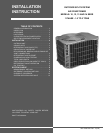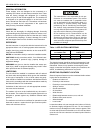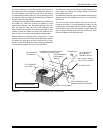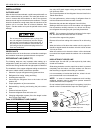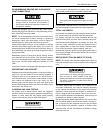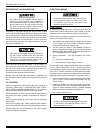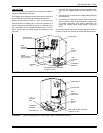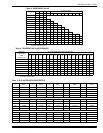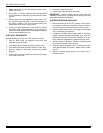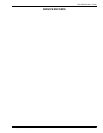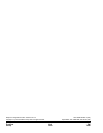
035-13606-003 Rev. A (202)
2 Unitary Products Group
GENERAL INFORMATION
These outdoor units are designed to be connected to a
matching UPG indoor coil with sweat connection lines. These
units are factory charged with refrigerant for a matching
indoor coil plus 15 feet of field supplied line. The outside unit
is designed to be placed alongside or at the back of the
home, remote from the indoor coil. The outdoor unit has been
factory run-tested and all components of the system are
ready for easy, immediate installation.
INSPECTION
Check the unit thoroughly for shipping damage, Unusually
rough handling during shipment may loosen fan motors, com-
pressors, or other components. Be sure that the unit is ready
to operate before installing it. If there is damage, file a claim
with the shipper. See Form 50.15-NM for more information.
REFERENCE
Use this instruction in conjunction with the instructions for the
appropriate indoor unit, air moving system and accessories.
Installer should pay particular attention to the words NOTE,
CAUTION and WARNING.
NOTES are intended to clarify or make the installation easier.
CAUTIONS identify procedures which, if not followed care-
fully, could result in personal injury, property damage or
equipment damage.
WARNINGS are given to alert the installer that severe per-
sonal injury, death or equipment damage may result if instal-
lation procedures are not followed properly.
LIMITATIONS
The unit should be installed in accordance with all national
and local codes and regulations which govern the installation
of this type of equipment. In lieu of local codes, the equip-
ment should be installed in accordance with National Electric
Code, and in accordance with the recommendations made by
the National Board of Fire Underwriters.
Limitations for the indoor unit, coil and appropriate accesso-
ries must also be observed.
The outdoor unit must not be installed with any duct work in
the air stream. The outdoor fan is the propeller type and is not
designed to operate against any additional external static
pressure.
The maximum and minimum conditions for operation must be
observed to assure a system that will give maximum perfor-
mance with minimum service.
CHECK ELECTRICAL POWER SUPPLY
The electrical power should be checked to determine if ade-
quate power is available, and near constant voltage can be
maintained. If there is any question concerning the power
supply, contact the local power company for corrections; oth-
erwise, unsatisfactory performance may result.
SELECTING EQUIPMENT LOCATION
Several important factors must be considered before select-
ing the site for the outdoor unit:
• Distance to indoor coil
• Proximity to the structure
• Proximity to vents and exhaust systems
• Ability to service
• Sound transmission
• Air circulation
• Wind direction
• Relationship between structure, sun, and unit
• Distance from power source
• Water drainage
• Local codes
Locate the outdoor unit near enough to the indoor coil vicinity
to eliminate lengthy refrigerant line runs. Do not locate the
outdoor unit so it discharges air under eaves or gutters. Rain
or snow melt-off should not be able to run off a roof and down
upon the unit. Be sure vents are not located upwind from the
outdoor unit.
The manufacturer is not responsible for the per-
formance of a mismatched system. The outdoor
unit must be installed with a compatible indoor
unit as designated in the specification data or in
the Directory of Certified Unitary Heat Pumps
published by the Air Conditioning and Refrigera-
tion Institute. Using unmatched components may
not only affect the performance of the system, but
may also void the warranty of the equipment.
Do not install any coil in a furnace which is to be
operated during the heating season without
attaching the refrigerant lines to the coil. Allowing
the coil charge to enter the refrigerant lines pre-
vents excessive refrigerant pressure build-up and
possible coil damage.
Table 1: APPLICATION LIMITATIONS
Ambient Air Temperature
on Outdoor Coil
Air Temperature on
Indoor Coil
Min. °DB Max. °DB Min. Max.
50 120 57 72



